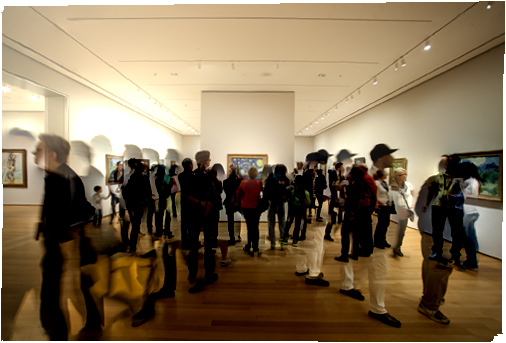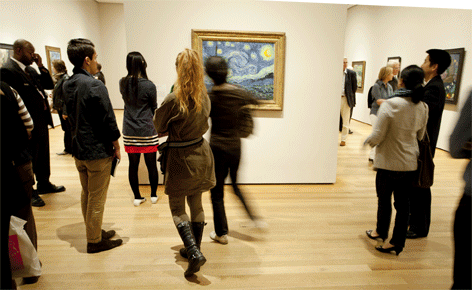
Crowds gather in the gallery on the fourth floor of the Museum of Modern Art in New York City to see Starry Night, Vincent Van Gogh’s masterpiece that hangs there, behind a nearly invisible sheet of glass. It really is something to see.
People mingle in front of Starry Night. Curiously, there are two other Van Gogh paintings on the wall to the right. No one seems to notice!
Painted by Van Gogh in 1889, the Starry Night is a study in color and style. It is the very image of impressionism. Scientists and scholars have photographed it, analyzed it, theorized about it, studied the layers of paint, and then written about their findings. In the end, everyone agrees it’s a very nice painting, certainly it’s Vincent’s best.
While admiring it last week in the museum, I found myself more impressed with the painting’s effect on people than the painting itself. This work of art overtakes people; they become enchanted by its brush strokes, they sigh; some weep. It’s quite amazing.
One could argue that the Mona Lisa (La Giaconda) by Leonardo da Vinci is more “valuable.” It might be, but it’s not as nice a painting. I have done the same act of people-watching in the Louvre as I did last week with Starry Night. People shuffle up to La Giaconda, they admire it, they comment on her eyes, they are scolded by the museum guards for using their strobe flashes. But it is not the same experience. La Giaconda is dark and somber, while Starry Night is emancipating and optimistic.
Seeing Starry Night is more of a pilgrimage, a religious experience. While in its presence, you become mesmerized by the interpretation of a night sky by a mentally disturbed 19th century painter. You wonder how he saw in that clear sky the brush strokes that make up this great work. Van Gogh was obsessed with becoming a better painter, and as most people know, the poor fellow never sold a painting in his lifetime (other than to his loving brother Theo). I’d say this is proof that he was a great painter.
People are so enchanted by Starry Night that they usually miss the other two Van Gogh paintings that hang within a few feet of the beautiful starry night. On the wall to its right are the Postman Joseph Roulin, and the Olive Trees, both painted the same year in the same town.
A person who studies the world of color could spend a while just considering how Van Gogh chose his colors, and how he made his paints. His palette was a superb selection of complements working together. In Starry Night are oranges and yellows that are perfect complements to the blues that make up the sky. This man knew his color theory, or he was genius enough to sense the proper colors to make the painting work.
When you are next in New York City, make the pilgrimage to see Starry Night. You will weep. With joy.



Thanks, Brian, for that marvelous presentation at SLOMUG last night. You helped to connect a lot of dots for me.